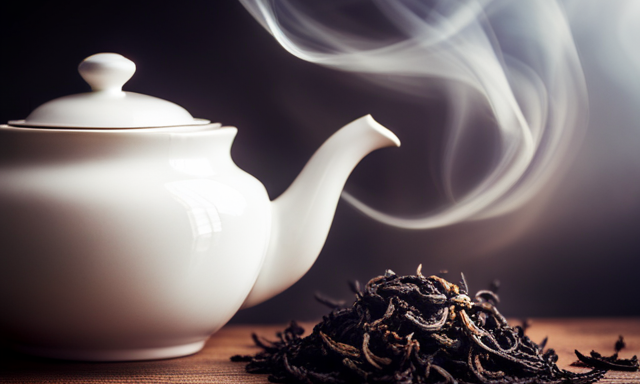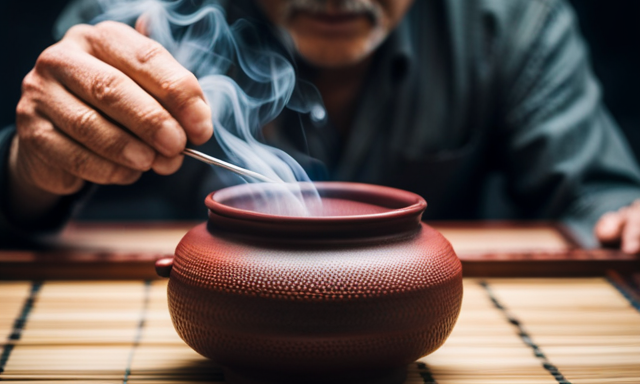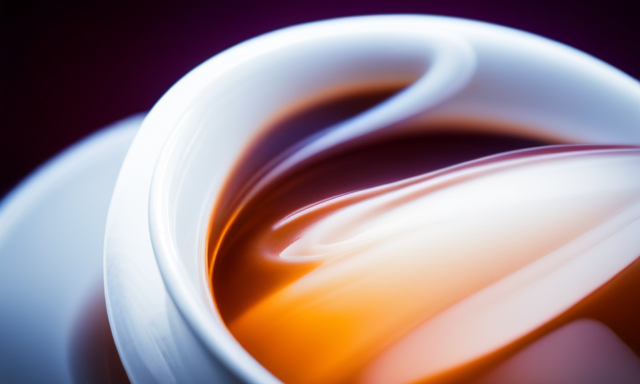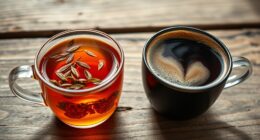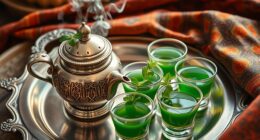Have you ever wondered how oolong tea stands apart from other teas? Well, let me take you on a journey to discover the unique qualities of this exquisite beverage.
Oolong tea, with its origins deeply rooted in the rich traditions of China, offers a flavor profile that is truly unparalleled. Its distinct combination of floral, fruity, and toasty notes creates a captivating sensory experience.
But that’s not all – oolong tea also boasts an array of health benefits. From boosting metabolism to promoting heart health, this tea is a true powerhouse.
Now, you might be wondering how oolong tea compares to other popular teas like green tea and black tea. Are there any significant differences? We’ll delve into that and explore the various varieties of oolong tea that are loved around the world.
So grab a cup of oolong tea and join me in this fascinating exploration of the world of tea. From its role in meditation to its rich cultural significance, oolong tea has so much to offer. Let’s dive in and uncover the secrets of this remarkable beverage.
Key Takeaways
- Oolong tea has unique qualities that set it apart from other teas.
- Oolong tea is partially oxidized, giving it a distinct flavor and aroma.
- Oolong tea offers health benefits, including boosting metabolism and promoting heart health.
- Oolong tea has popular varieties like Tie Guan Yin and Da Hong Pao with distinct characteristics.
The Origins of Oolong Tea
Did you know that oolong tea has a fascinating history that dates back centuries? The origins of oolong tea can be traced back to China, where it holds great cultural significance.
Oolong tea is believed to have been discovered during the Ming Dynasty, and it quickly gained popularity among the Chinese elite. The tea leaves are partially oxidized, giving oolong tea a unique flavor and aroma that sets it apart from other teas.
The process of making oolong tea involves withering the leaves under the sun, and then gently bruising and partially fermenting them. This intricate process results in a tea that has a complex flavor profile, ranging from floral and fruity to toasty and earthy.
Transitioning into the next section, let’s explore the flavor profile of oolong tea.
Flavor Profile of Oolong Tea
Have you ever savored the unique flavor profile of oolong tea? Oolong tea is known for its exquisite taste that sets it apart from other teas. Its flavor intensity can range from mild and floral to bold and fruity, offering a delightful experience for tea connoisseurs.
The aroma notes of oolong tea are diverse, with hints of honey, orchid, and even roasted nuts. This complexity is a result of the unique semi-oxidation process that oolong tea undergoes, which beautifully balances the characteristics of both green and black teas.
To truly appreciate the depth of oolong tea’s flavors, it is important to pay attention to two sub-lists of details:
-
The color of the brewed tea, which can vary from light golden to deep amber, indicating the level of oxidation and influencing the taste.
-
The region where the oolong tea is grown, which can contribute to distinctive flavor profiles, such as the famous floral notes of Taiwanese oolongs or the earthy and robust flavors of Chinese oolongs.
Now, let’s explore the health benefits of oolong tea.
Health Benefits of Oolong Tea
Immerse yourself in the world of oolong tea and discover how it can invigorate your health and wellbeing. Oolong tea offers a range of benefits that can aid in weight loss and improve digestion.
Its unique combination of polyphenols and caffeine can help boost metabolism, making it an excellent addition to a weight loss regimen. Additionally, oolong tea contains compounds that promote healthy digestion by reducing inflammation in the gut and aiding in the breakdown of fats and carbohydrates. Studies have shown that regular consumption of oolong tea can lead to improved digestion and reduced bloating.
Transitioning into the subsequent section about oolong tea versus green tea, it’s important to note that while both teas offer health benefits, oolong tea has distinct advantages in terms of weight management and digestive health.
Oolong Tea vs. Green Tea
Indulge in the delightful debate between oolong tea and green tea, and let your taste buds savor the captivating clash of flavors. Oolong tea, like green tea, offers a myriad of health benefits. Packed with antioxidants, it helps boost metabolism, aids in weight loss, and promotes overall well-being.
What sets oolong tea apart is its unique processing method. After the leaves are harvested, they undergo partial oxidation, making it fall between the categories of green and black tea. This process gives oolong tea its distinct flavor profile, with a delightful balance of floral and fruity notes. The rich taste of oolong tea makes it a perfect choice for those who prefer a more complex and nuanced tea experience.
As we delve into the next section about oolong tea versus black tea, let’s explore the differences in their processing and flavors.
Oolong Tea vs. Black Tea
Prepare yourself to discover the intricate contrasts between oolong tea and black tea, as you embark on a journey to unravel the distinctive flavors and processing methods of these two remarkable teas.
Oolong tea and black tea differ not only in taste but also in appearance and health benefits. While black tea undergoes a complete oxidation process, oolong tea is only partially oxidized, resulting in a unique flavor profile that lies between green and black tea. Black tea tends to have a bolder, stronger taste, while oolong tea offers a delicate and complex flavor with floral and fruity notes.
Additionally, oolong tea is known for its numerous health benefits, including boosting metabolism and promoting heart health.
Transitioning into the subsequent section about traditional preparation and serving methods, it is fascinating to explore how these teas are enjoyed and cherished around the world.
Traditional Preparation and Serving Methods
Savor the splendid traditions of serving and steeping these exceptional teas, as you delve into the delightful details of their preparation methods. In the realm of oolong tea, traditional tea ceremonies hold immense cultural significance. These ceremonies, rooted in ancient Chinese customs, highlight the elegance and artistry of tea preparation.
Here are four key elements of the traditional preparation and serving methods:
-
Teaware: Traditional tea ceremonies call for specific teaware, such as clay teapots and small tea cups, designed to enhance the flavors and aromas of oolong tea.
-
Ritualistic Steps: Each step of the tea preparation process is carefully executed, including the rinsing of teaware, the precise measurement of tea leaves, and the controlled infusion of water.
-
Steeping Time: Oolong tea requires precise steeping times, ranging from 30 seconds to several minutes, depending on the desired flavor profile.
-
Presentation: Oolong tea is often served in small cups, allowing for multiple infusions, and the host presents the tea with grace and humility.
Transitioning to the subsequent section about popular varieties of oolong tea, it’s fascinating to explore the diverse flavors and characteristics that these teas possess.
Popular Varieties of Oolong Tea
When it comes to popular varieties of oolong tea, two names that immediately come to mind are Tie Guan Yin, also known as Iron Goddess, and Da Hong Pao, or Big Red Robe.
Tie Guan Yin is known for its floral aroma and smooth, mellow taste, making it a favorite among oolong enthusiasts.
On the other hand, Da Hong Pao is prized for its rich, roasted flavor and complex notes, which can vary from chocolatey to fruity.
These two teas have distinct characteristics that set them apart, making them highly sought after by tea connoisseurs.
Tie Guan Yin (Iron Goddess)
Imagine yourself sitting in a serene tea garden, sipping on a cup of Tie Guan Yin, its delicate floral aroma and smooth, creamy taste enveloping your senses. Tie Guan Yin, also known as Iron Goddess, is a popular variety of oolong tea with a rich history and unique characteristics.
It is produced through a meticulous process that involves plucking the leaves, withering them under the sun, and then carefully oxidizing and roasting them to perfection. The result is a tea with a beautiful amber color and a complex flavor profile that balances floral notes with hints of fruit and a subtle earthiness.
Tie Guan Yin is highly regarded for its health benefits, which include aiding digestion and promoting relaxation. As you finish your last sip, you can’t help but wonder about the next variety of oolong tea to explore, the renowned Da Hong Pao.
Da Hong Pao (Big Red Robe)
As you take a sip of Da Hong Pao, let the robust warmth of its flavor transport you to a majestic mountainside. The ancient tea trees stand tall, their leaves steeped in history and tradition. Da Hong Pao, also known as Big Red Robe, is a highly revered oolong tea with numerous health benefits.
Not only does it possess a rich, earthy taste, but it’s also believed to aid in weight loss. This is due to its ability to boost metabolism and promote fat oxidation. The unique combination of antioxidants and polyphenols found in Da Hong Pao helps to enhance digestion and regulate blood sugar levels.
With its well-rounded flavor profile and potential weight loss benefits, Da Hong Pao is truly a remarkable addition to the world of oolong tea.
Transitioning into the next section, oolong tea as a versatile beverage offers even more reasons to incorporate it into your daily routine.
Oolong Tea as a Versatile Beverage
Oolong tea is a versatile beverage that can be enjoyed in various ways. When it comes to serving, I often find myself torn between the comforting warmth of a hot cup of oolong tea and the refreshing coolness of iced oolong tea.
Additionally, oolong tea can also be used in cooking and baking, adding a unique flavor profile to dishes and desserts. Its complex and nuanced taste makes it a delightful ingredient to experiment with in the kitchen.
Hot tea vs. iced tea
Nothing beats the refreshing chill of a tall glass of iced tea on a scorching summer day. Not only does it quench your thirst, but it also offers a myriad of benefits. Here are three reasons why iced tea is a perfect choice:
-
Hydration: Staying hydrated is crucial, especially during the hot summer months. Iced tea helps replenish fluids in your body, keeping you cool and preventing dehydration.
-
Antioxidants: Just like hot tea, iced tea is rich in antioxidants that help fight off harmful free radicals. These compounds contribute to a healthy immune system and may even reduce the risk of chronic diseases.
-
Versatility: Iced tea can be customized with various flavors and ingredients, allowing you to create unique and refreshing recipes. From fruity infusions to herbal blends, the possibilities are endless.
As we delve into the culinary uses of oolong tea in cooking and baking, it’s important to explore its versatility beyond a simple beverage.
Culinary uses in cooking and baking
Indulging in the culinary wonders of oolong tea can add a touch of magic to your cooking and baking creations, transforming ordinary dishes into enchanting culinary delights. Oolong tea, with its unique flavor profile and versatile nature, can be used in a variety of culinary techniques to enhance the taste and aroma of your dishes. From savory recipes like oolong-infused marinades and dressings to sweet treats like oolong tea-infused cakes and cookies, the possibilities are endless. Not only does oolong tea elevate the flavor of your dishes, but it also brings along various health benefits. Packed with antioxidants and polyphenols, oolong tea promotes digestion, boosts metabolism, and supports weight loss. Its calming properties can also help reduce stress and anxiety. Transitioning into the subsequent section about oolong tea and meditation, incorporating this versatile tea into your daily routine can create a harmonious balance between body and mind.
Oolong Tea and Meditation
Take a moment to relax and let the soothing aroma of oolong tea waft through your senses as you delve into a state of peaceful meditation. Oolong tea, known for its unique flavor and numerous health benefits, can also aid in stress reduction and focus enhancement.
The combination of natural compounds found in oolong tea, such as L-theanine and caffeine, helps to promote a sense of calmness while sharpening cognitive abilities. The gentle, yet invigorating, effects of oolong tea make it an ideal companion for meditation practices, allowing you to achieve a deeper level of relaxation and focus.
By incorporating oolong tea into your meditation routine, you can experience a heightened sense of tranquility and mental clarity. Now, let’s continue our exploration of oolong tea culture.
Exploring Oolong Tea Culture
After exploring the connection between Oolong Tea and meditation, let’s delve into the fascinating world of Oolong Tea culture. As an avid tea enthusiast, I find the artistry and rituals of tea ceremonies captivating. Oolong Tea has a rich history rooted in Chinese culture, and its preparation and presentation are often imbued with deep meaning and symbolism.
To showcase the beauty of Oolong Tea culture, I have created a table that evokes a sense of tranquility and appreciation for this ancient tradition:
| Harmony | Tranquility |
|---|---|
| Elegance | Serenity |
| Grace | Meditation |
| Balance | Mindfulness |
Moreover, Oolong Tea has been the subject of numerous health studies, highlighting its potential benefits. Research suggests that Oolong Tea may aid in weight management, promote heart health, and enhance brain function. These findings further contribute to the allure and popularity of Oolong Tea, making it not only a delightful beverage but also a potential ally in maintaining overall well-being.
Frequently Asked Questions
What is the caffeine content of oolong tea compared to other teas?
Compared to other teas, oolong tea packs a punch with its moderate caffeine levels. But let’s not forget its health benefits, like boosting metabolism and aiding digestion. It’s a win-win situation, my friends.
Can oolong tea be consumed by individuals with certain health conditions or on medication?
Oolong tea can be effective for weight loss, but individuals with certain health conditions or on medication should be cautious. Oolong tea may interact with specific medications, so it’s best to consult with a healthcare professional.
Does oolong tea have a specific brewing temperature or steeping time?
For oolong tea, it is best to brew it at a temperature of 180-190°F (82-88°C) and steep it for 3-5 minutes. This will ensure a balanced flavor and the optimal extraction of its unique characteristics.
Are there any specific storage requirements for oolong tea to maintain its freshness and flavor?
To maintain the freshness and flavor of oolong tea, it’s crucial to store it in a well-sealed container away from light, heat, and moisture. This ensures that every sip keeps its delightful essence intact.
Can oolong tea be blended with other ingredients or flavors to enhance its taste?
Oolong tea can indeed be blended with various ingredients and flavors to enhance its taste. This opens up a wide range of blending possibilities, allowing for unique and personalized combinations. Additionally, oolong tea offers numerous health benefits, making it a great choice for blending.
Conclusion
In conclusion, after exploring the origins, flavor profile, health benefits, and cultural significance of oolong tea, it’s clear that this beverage is truly unique. Its delicate yet complex taste, combined with its numerous health benefits, sets it apart from other teas.
Whether you prefer the earthiness of black tea or the grassy notes of green tea, oolong tea offers a balance of both worlds. So why not indulge in a cup of oolong tea and let its soothing properties transport you to a state of tranquility and mindfulness?

